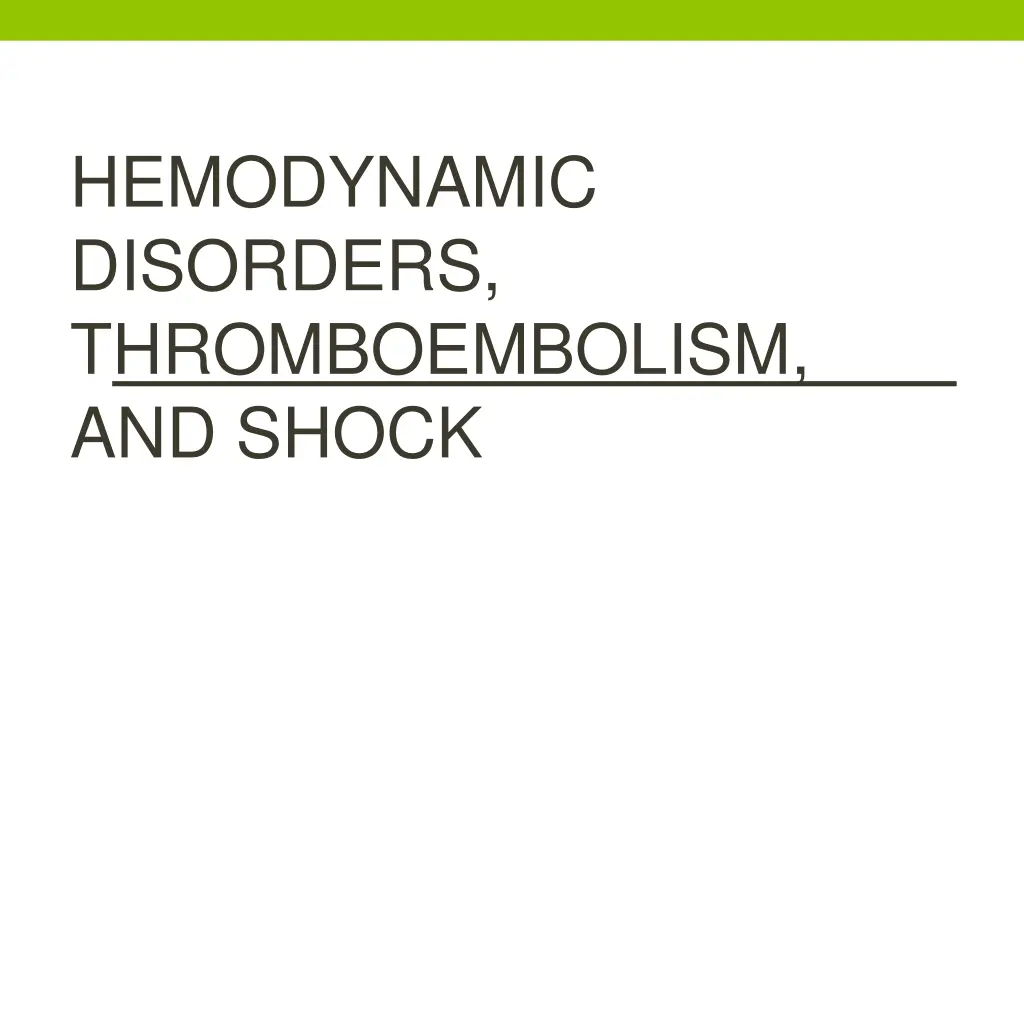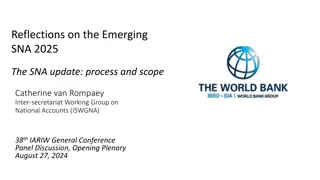
Understanding Hemodynamic Disorders, Thromboembolism, and Shock
Explore the basics of hemodynamic disorders, thromboembolism, and shock, including the impact on circulation, causes of edema, hyperemia, congestion, and more. Learn about acute and chronic conditions affecting the lungs and tissues due to circulatory issues.
Uploaded on | 3 Views
Download Presentation

Please find below an Image/Link to download the presentation.
The content on the website is provided AS IS for your information and personal use only. It may not be sold, licensed, or shared on other websites without obtaining consent from the author. If you encounter any issues during the download, it is possible that the publisher has removed the file from their server.
You are allowed to download the files provided on this website for personal or commercial use, subject to the condition that they are used lawfully. All files are the property of their respective owners.
The content on the website is provided AS IS for your information and personal use only. It may not be sold, licensed, or shared on other websites without obtaining consent from the author.
E N D
Presentation Transcript
HEMODYNAMIC DISORDERS, THROMBOEMBOLISM, AND SHOCK
Introduction The health of cells and tissues depends on the circulation of blood. Normal proteins in the plasma are retained within the vasculature - there is little net movement of water and electrolytes into the tissues Pathologic conditions alter endothelial function, increase vascular pressure, or decrease plasma protein content, all of which promote edema.
Overview Edema (increased fluid in the ECF) Hyperemia (INCREASED flow) Congestion (INCREASED backup) Hemorrhage (extravasation) Hemostasis (opposite of thrombosis)
Overview Hemostasis (opposite of thrombosis) Thrombosis (inappropriate clotting blood) Embolism (downstream travel of a clot) Infarction (death of tissues w/o blood) Shock (circulatory failure/collapse)
Hyperemia an active process resulting from arteriolar dilation and increased blood inflow, as occurs at sites of inflammation or in exercising skeletal muscle Hyperemic tissues are redder than normal because of engorgement with oxygenated blood.
Congestion a passive process resulting from impaired outflow of venous blood from a tissue It can occur systemically, as in cardiac failure, or locally as a consequence of an isolated venous obstruction. Congested tissues have an abnormal blue-red color (cyanosis) that stems from the accumulation of deoxygenated hemoglobin in the affected area.
ACUTE PASSIVE HYPEREMIA/CONGESTION, LUNG The typical picture of acute pulmonary edema is congested alveolar vessels with transudate inside of the alveoli.
Chronic Pulmonary Congestion the septa become thickened and fibrotic, and the alveolar spaces contain numerous macrophages laden with hemosiderin ( heart failure cells ) derived from phagocytosed red cells
CHRONIC PASSIVE HYPEREMIA/CONGESTION, LUNG
Acute Hepatic Congestion the central vein and sinusoids are distended with blood, and there may even be central hepatocyte dropout due to necrosis The periportal hepatocytes, better oxygenated because of their proximity to hepatic arterioles, experience less severe hypoxia and may develop only reversible fatty change.
Acute Passive Congestion, Liver The red dots are congested central veins.
Chronic Passive Congestion of the liver the central regions of the hepatic lobules, viewed on gross examination, are red- brown and slightly depressed (owing to cell loss) and are accentuated against the surrounding zones of uncongested tan, sometimes fatty liver (nutmeg liver)
CHRONIC PASSIVE HYPEREMIA/CONGESTION, LIVER
Flattened gyri due to compression against the calvarium An example of an organ which is edematous, but does not have room to swell.
Edema is the result of the movement of fluid from the vasculature into the interstitial spaces; the fluid may be protein-poor (transudate) or protein-rich (exudate) -------------------- ---- 2021-03-09 05:46:04 -------------------- Microscopic examination shows clearing and separation of the extracellular matrix elements.
Edema Although any tissue can be involved, edema most commonly is encountered in subcutaneous tissues, lungs, and brain. ANASARCA - severe, generalized edema marked by profound swelling of subcutaneous tissues and accumulation of fluid in body cavities
WATER 60% of body 2/3 of body water is INTRA-cellular The rest is INTERSTITIAL Only 5% is INTRA-vascular EDEMA is SHIFT to the INTERSTITIAL SPACE HYDRO- -THORAX, -PERICARDIUM, -PERITONEAL EFFUSIONS, ASCITES, ANASARCA
Edema may be caused by: 1. increased hydrostatic pressure (e.g., heart failure) 2. increased vascular permeability (e.g., inflammation) 3. decreased colloid osmotic pressure, due to reduced plasma albumin decreased synthesis (e.g., liver disease, protein malnutrition) increased loss (e.g., nephrotic syndrome) 4. lymphatic obstruction (e.g., inflammation or neoplasia). 5. sodium retention (e.g., renal failure)
Subcutaneous Edema can be diffused but usually accumulates preferentially in parts of the body positioned the greatest distance below the heart where hydrostatic pressures are highest Thus, edema typically is most pronounced in the legs with standing and the sacrum with recumbency, a relationship termed dependent edema. Pitting edema - a finger-shaped depression when the finger leaves pressure over edematous subcutaneous tissue that displaces the interstitial fluid
Hemorrhage defined as the extravasation of blood from vessels, occurs in a variety of settings Trauma, atherosclerosis, or inflammatory or neoplastic erosion of a vessel wall also may lead to hemorrhage, which may be extensive if the affected vessel is a large vein or artery.
Hemorrhage: Manifestations Hematoma may be external or may accumulate in tissues which ranges in significance from trivial (e.g., a bruise) to fatal (e.g., a massive retroperitoneal hematoma resulting from rupture of a dissecting aortic aneurysm) Examples - hemothorax, hemopericardium, hemoperitoneum, or hemarthrosis (in joints) Petechiae - minute (1 to 2 mm in diameter) hemorrhages into skin, mucous membranes, or serosal surfaces; causes include low platelet counts (thrombocytopenia), defective platelet function, and loss of vascular wall support, as in vitamin C deficiency
Hemorrhage: Manifestations Purpura - slightly larger (3 to 5 mm) hemorrhages which can result from the same disorders that cause petechiae, as well as trauma, vascular inflammation (vasculitis), and increased vascular fragility. Ecchymoses - larger (1 to 2 cm) subcutaneous hematomas (colloquially called bruises). Extravasated red cells are phagocytosed and degraded by macrophages; the characteristic color changes of a bruise are due to the enzymatic conversion of hemoglobin (red-blue color) to bilirubin (blue-green color) and eventually hemosiderin (golden-brown).
A B A, Punctate petechial hemorrhages of the colonic mucosa, a consequence of thrombocytopenia. B, Fatal intracerebral hemorrhage.
Embolism An embolus is an intravascular solid, liquid, or gaseous mass that is carried by the blood to a site distant from its point of origin. The vast majority of emboli derived from a dislodged thrombus hence the term thromboembolism. The primary consequence of systemic embolization is ischemic necrosis (infarction) of downstream tissues, while embolization in the pulmonary circulation leads to hypoxia, hypotension, and right-sided heart failure.
Embolus derived from a lower-extremity deep venous thrombus lodged in a pulmonary artery branch.
Unusual types of emboli. A, Bone marrow embolus. The embolus is composed of hematopoietic marrow and marrow fat cells (clear spaces) attached to a thrombus. B, Amniotic fluid emboli. Two small pulmonary arterioles are packed with laminated swirls of fetal squamous cells. The surrounding lung is edematous and congested. (Courtesy of Dr. Beth Schwartz, Baltimore, Maryland.)
Infarction An infarct is an area of ischemic necrosis caused by occlusion of the vascular supply to the affected tissue. Arterial thrombosis or arterial embolism underlies the vast majority of infarctions. Other uncommon causes of tissue infarction include vessel twisting (e.g., in testicular torsion or bowel volvulus), traumatic vascular rupture, and entrapment in a hernia sac.
B A Red and white infarcts. A, Hemorrhagic, roughly wedge-shaped pulmonary infarct (red infarct). B, Sharply demarcated pale infarct in the spleen (white infarct).
Shock the final common pathway for several potentially lethal events, including exsanguination, extensive trauma or burns, myocardial infarction, pulmonary embolism, and sepsis characterized by systemic hypoperfusion of tissues; it can be caused by diminished cardiac output or by reduced effective circulating blood volume The consequences are impaired tissue perfusion and cellular hypoxia.






















